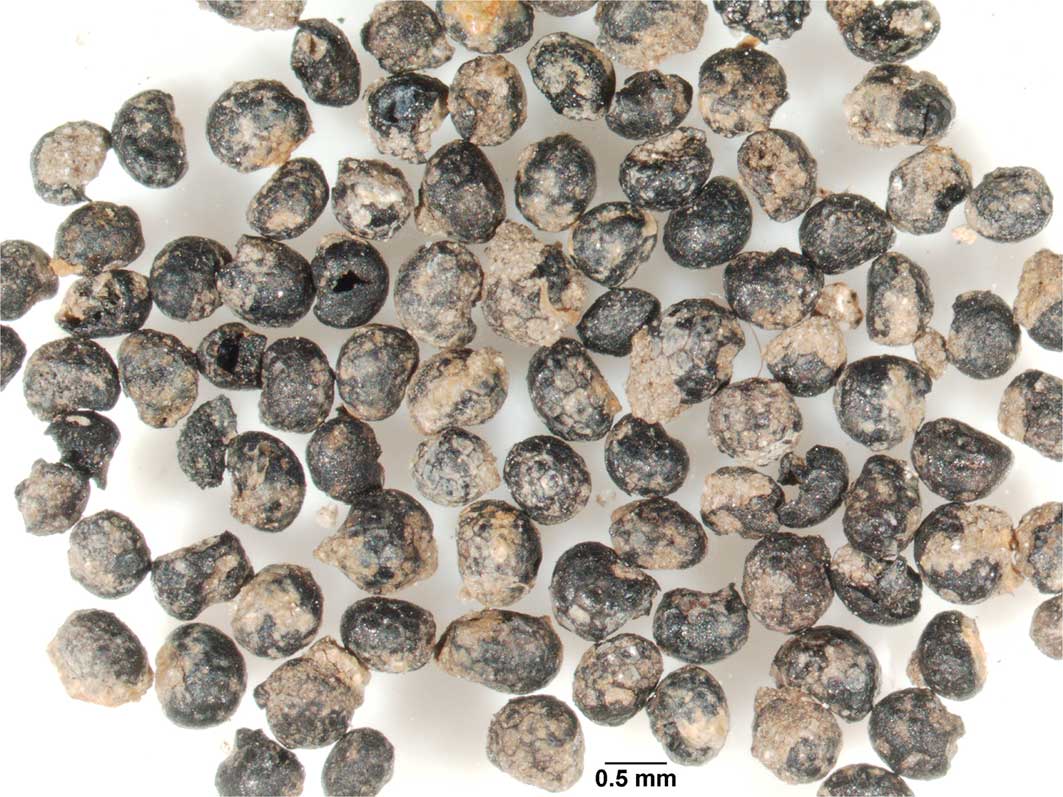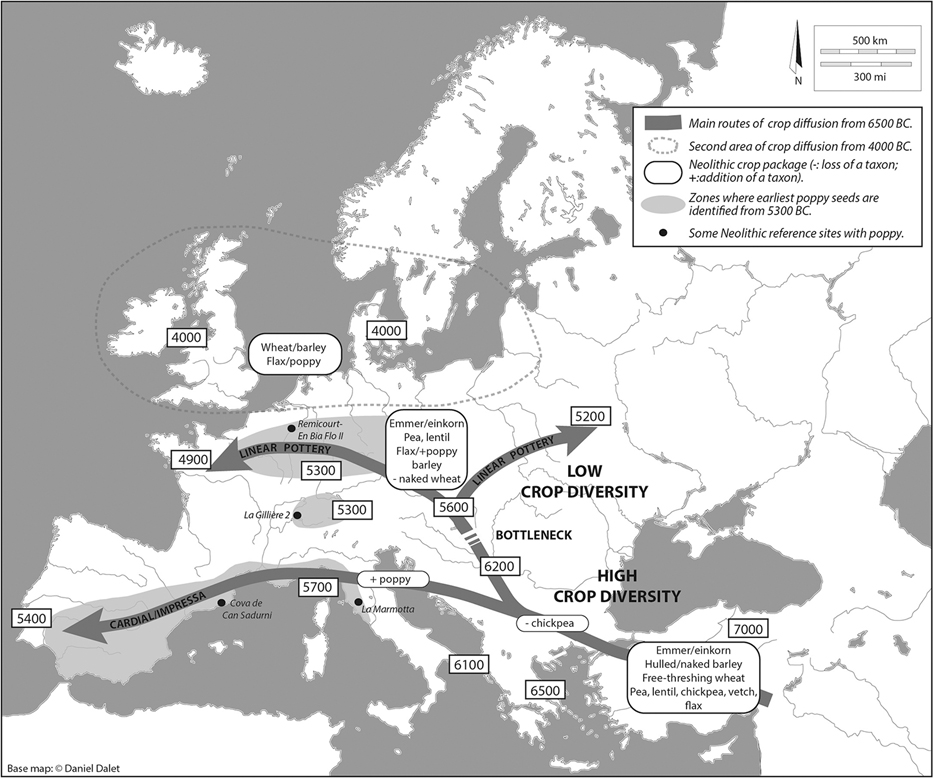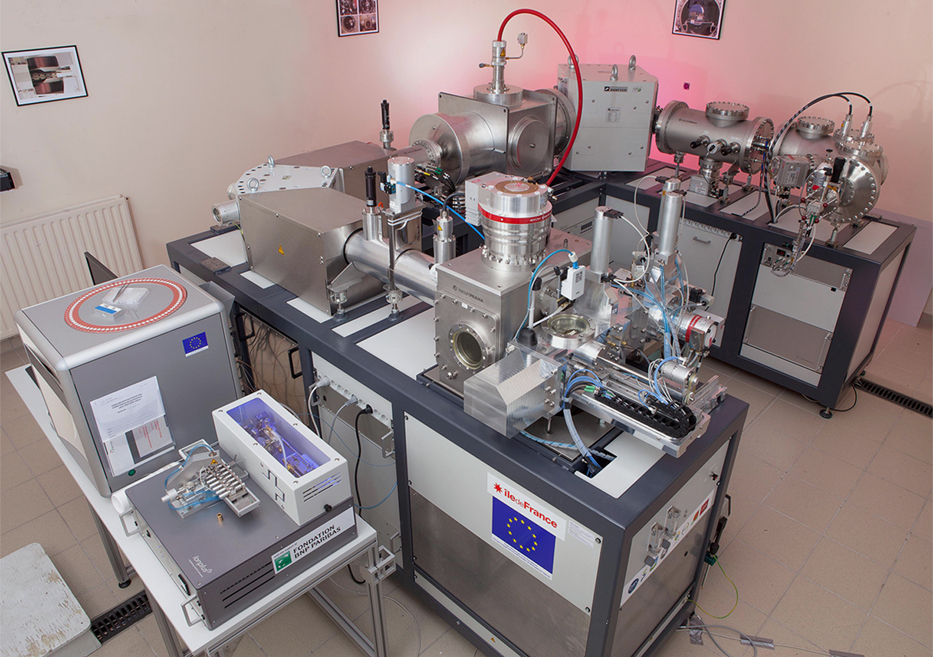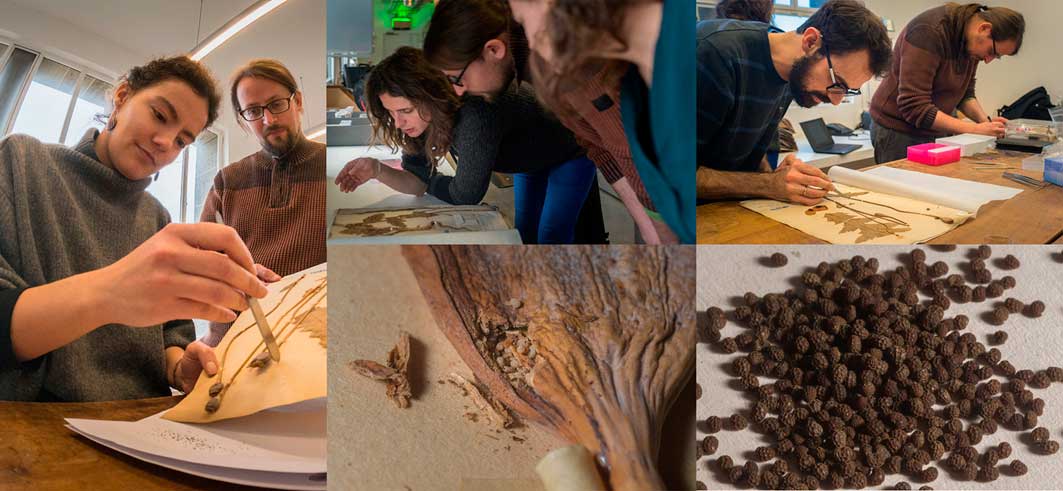Introduction
The opium poppy (Papaver somniferum L.) has been of economic, therapeutic and symbolic importance for thousands of years, as evidenced by reference to opium production in fourth-millennium BC Sumerian clay tablets (Kritikos & Papadaki Reference Kritikos and Papadaki1967). In the absence of historical sources, archaeological seeds (and, only rarely, capsules and stigmatic disks) constitute the most direct and reliable evidence of the presence, use and cultivation of opium poppies in the past (Figure 1).

Figure 1 Charred Early Neolithic Papaver somniferum seeds from Buchères, France (photograph: F. Toulemonde).
It is hypothesised that opium poppies were originally cultivated in the Mediterranean basin from the middle of the sixth millennium BC, where its putative wild ancestor—Papaver somniferum subsp. setigerum—developed (Hammer & Fritsch Reference Hammer and Fritsch1979; Schultze-Motel Reference Schultze-Motel1979). To date, however, the most frequent discoveries of Papaver somniferum beyond the Mediterranean region are from Linear Pottery Culture sites (5300–4900 BC); it thus followed a dispersal pattern from south to north (Bakels Reference Bakels1996; Salavert Reference Salavert2011) (Figure 2). The opium poppy is found in the Alpine region by the beginning of the fifth millennium BC (Martin Reference Martin2015). This distribution raises the question of the diffusion process and the status of the plant. Why was it so rapidly adopted by Early Neolithic farmers in the north of continental Europe and the Alps at the end of the sixth millennium BC? Opium poppies do not seem to have followed the same dispersal trajectories as the cereals and pulses that accompanied the first farmers from the Near East to Western Europe, where the earliest finds of poppies, dating from 5300 BC onwards, are concentrated (Salavert Reference Salavert2010, Reference Salavert2017; Antolín et al. Reference Antolín, Jacomet and Buxó2015). The opium poppy, therefore, may be the only plant whose domestication process began in Neolithic Europe.

Figure 2 Chronological framework of cultivated plant dispersal during the Neolithic and the first evidence for the opium poppy in Western Europe (modified from Salavert Reference Salavert2017).
Several obstacles currently prevent us from progressing the study of ancient poppy cultivation. The chronological framework covering the origins and distribution of the opium poppy is somewhat imprecise, being based on indirect and low-resolution dates. In addition, the native distribution area and the wild ancestor of the cultivated opium poppy are not identified with certainty; this strongly limits the hypotheses about the location of its early cultivation. Furthermore, the first uses and socio-economic status of the plant have been difficult to define due to their sparse representation in the archaeological record.
Aims of the project and methodology
This one-year project aims to reveal the origin of the opium poppy as a cultivar, and its spread across other regions, by providing a solid chronological framework. We will perform AMS dating of seeds from annual plants recovered from the same sieves as poppy seeds at approximately 40 Neolithic reference sites. Poppy seeds will also be directly dated, although low sample weight (typically 10–30µg per seed) presents a challenge. To overcome this, we will use the mini radiocarbon dating system installed at Gif-sur-Yvette in France (ECHo-MICADAS), which allows for analysis of very small samples (Figure 3). The results will then be analysed using a geographic information system (open-source software, QGIS©), in order to identify the potential cradle(s), rhythms and diffusion processes of the opium poppy in Neolithic Western Europe. The project also aims to create a European interdisciplinary network to study the history of the opium poppy over a longer period of time and larger geographic area (Figure 4).

Figure 3 ECHo-MICADAS, the mini radiocarbon dating system at Gif-sur-Yvette, France (photograph: F. Rhodes/CEA).

Figure 4 Sampling of seeds from historical specimens of Papaver somniferum at the Herbier national of the Muséum national d’Histoire naturelle in Paris for morphometric-geometric analysis (photograph: R. Soteras).
Acknowledgements
This project ‘Origine et premières diffusions du pavot somnifère en Europe au Néolithique’ has received a research grant from the Fyssen Foundation. We would like to thank the following colleagues for their helpful advice and for providing seeds to the radiocarbon programme: C. Bakels, A. Bienek, N. Bleicher, E. Bonnaire, L. Bouby, C. Bouchaud, C. Brombacher, L. Castelletti, P.-A. Chouvy, I. Vostrovska, F. Jabbour, P. Marinval, R. Nisbet, M. Rottoli, N. Rovira, A. Schlumbaum, F. Toulemonde, O. Tombret, A. de Vareilles-Sommières, A. Jesus, R. Soteras and A. Fortó. We also acknowledge the GDRE Bioarch and the SNSF Professorship funding (PP00P1_170515) for the biometric analyses of poppy seeds (coordination: F. Antolín).






